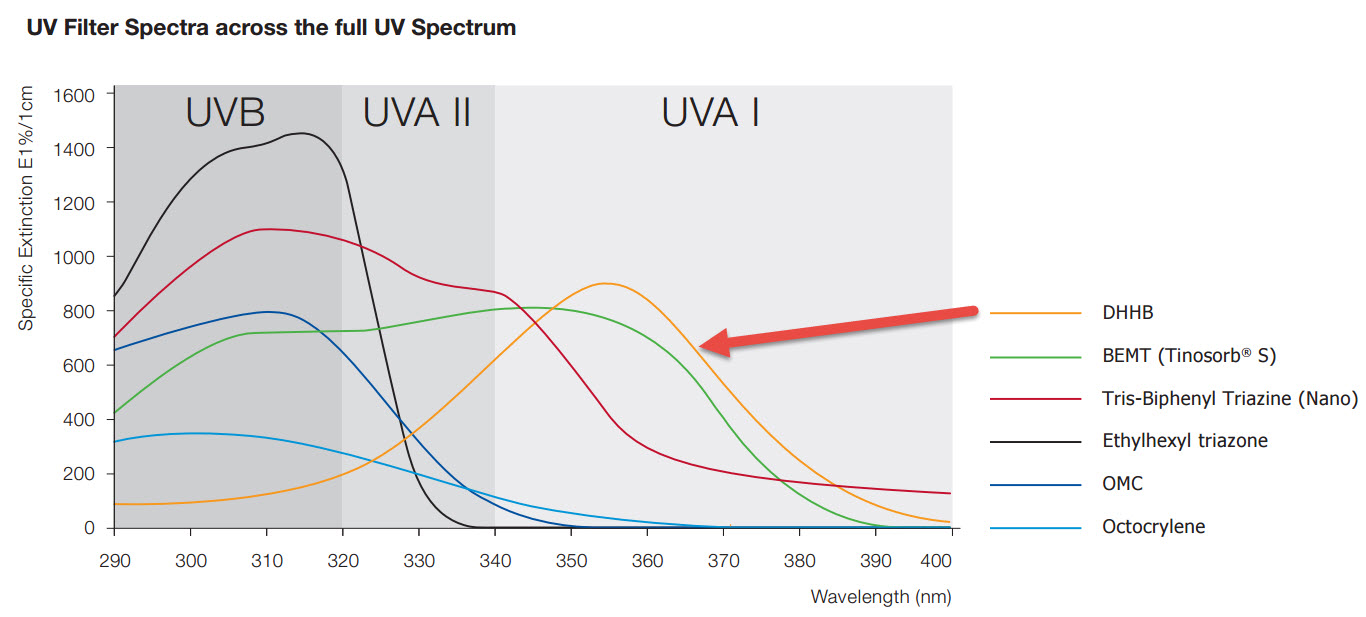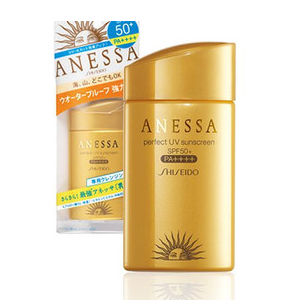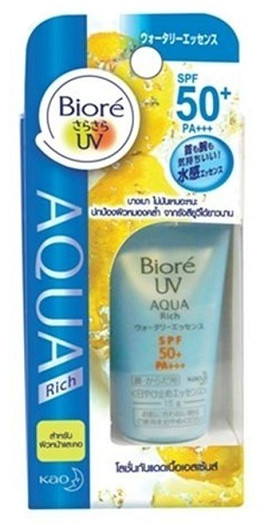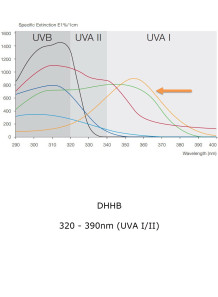DHHB (Diethylamino Hydroxybenzoyl Hexyl Benzoate, eq. Uvinul A Plus)
- Product Code: 528
Organic Sunscreen or Chemical Sunscreen that can block UVA light in the wavelength range of 320-390nm can work well with other sunscreens. and is highly stable under sunlight
- -
- -
- -
- -
- -
- -
- -
- -
- -
- -
- -
- -
- -
- -
- -
- -
- -
- -
| Test Name | Specification |
|---|---|
| Apperance | White-slightly salmon granul powder. Turns yellow when melts |
| Odour | Weakly characteristics |
| Identification (UV) | 352-356nm |
| Colour Gardner (Molten manner) | 8.2 Max |
| Specific Absorption (E1/1) (354nm in Ethanol) | 910-940 |
| Bulk Density (g/ml) | 0.58-0.70 |
| Purity (GC) | 98.0 Min |
Organic Sunscreen or Chemical Sunscreen that can block UVA light in the wavelength range of 320-390 nm can work well with other sunscreens. and is highly stable under sunlight There is no problem of faster deterioration when exposed to sunlight like Avobenzone .
DHHB prefers to call the trade name Uvinul A Plus, this product is not produced by the manufacturer Uvinul A Plus, this product is guaranteed to be as pure as Uvinul A Plus, orders over 10kg, the company provides a free SPF testing service for orders over 10kg. 20kg Test the purity of substances with GCMS for free with every order.
DHHB is used in expensive high-end sunscreen products because of its high effectiveness. And it is very stable in terms of protecting against UVA light. It is recommended that DHHB be used in sunscreen products that are used on the face only. Due to the high price If sunscreen products are used on the body It is recommended to use high amounts of Zinc Oxide to protect against UVA light instead as it is cheaper. Although the nature of the product (It may give whiteness - difficult to blend - there is a chance of separation) It cannot be equivalent to DHHB. DHHB does not cause whiteness. Creamy texture, easy to spread And easy to mix, no separation problems.
Summary of DHHB features
-It is an organic sunscreen that can block UVA well and is highly stable. even under sunlight There is no need to use other sunscreens in the formula to increase stability. This is different from Avobenzone. Although it blocks UVA well, it is not stable. It is necessary to use other sunscreens to help increase stability.
-Can be used with Physical Sunscreen such as Zinc Oxide or Titanium Dioxide without affecting stability. This is different from Avobenzone which cannot be used with Zinc Oxide , Titanium Dioxide and OMC because it will cause Avobenzone to lack stability. This causes limitations in increasing SPF and PA values in formulas because there are limitations in selecting other ingredients that can help increase SPF and PA values, especially OMC , which is a highly effective UVB sunscreen.
-Although unable to protect against UVB light, when used together with other types of organic UVB sunscreens It can help increase the SPF (UVB light protection) value even more.
DHHB is a highly effective UVB-specific sunscreen. When comparing the value of Specific Extinction E1%/1cm

FDA rules for using DHHB in any type of cosmetics
Europe (including Thailand): not more than 10%
Japan: no more than 10%
Products using this ingredient cannot be exported to America because the US FDA has not approved DHHB.
SPF/PA calculation
For UVA: 5% DHHB = PA+++ and >7.5% DHHB = PA++++
For UVB: DHHB is not effective in blocking UVB when used alone, but has the ability to boost SPF values with other UVB sunscreens when used together in a formula. (Please see additional details below)
DHHB has the ability to add SPF to the UVB sunscreen in the formula (SPF-Booster).
From the research results it was found that In formulas that use DHHB together with other UVB sunscreens such as OMC, increasing the use of DHHB from 2.5% to 10% will increase the SPF value of the formula (which is mainly obtained from OMC) by 2-3 times.
Dissolving DHHB in various sunscreens and LipidSoft
Because DHHB is a powder, the formula must be mixed with a solvent.
Up to 39% soluble in Octocrylene (DHHB 39% in Octocrylene 100%).
Soluble up to 39% in OMC (DHHB 39% in OMC 100%).
Soluble up to 36% in Homosalate (DHHB 36% in Homosalate 100%).
Soluble up to 30% in Octisalate (DHHB 30% in Octisalate 100%).
Solubility up to 23% in LipidSoft (DHHB 23% in LipidSoft 100%)
Example of using DHHB
-Use in a normal cream formula (Day-Cream) for skin that is not outdoors. but travel outside the shaded area during the day Specifically to protect against UVA light, use at a level of 2-5%.
-Used specifically in sunscreen formulas. For skin that goes outdoors or play outdoor sports Suitable for use in conjunction with Zinc Oxide , using 7-10% Zinc Oxide as the main source and using 2.5-5% as a secondary DHHB to protect against UVA light to achieve a PA level of ++++ and above and using other UVB sunscreens. Join to get SPF of at least 25.
Ready-made sunscreen products using DHHB It is a sunscreen. Do not refrigerate. Refrigeration will reduce the sunscreen efficiency of the sunscreen group. Organic/Chemical has decreased efficiency Due to the recrytalization
Usage rate: 1-10% ( 1. Recommended 2.5-3% when used together with Zinc Oxide to protect from UVA light. 2. Recommended 5-7.5% if used as a single ingredient to protect from UVA light. )
Appearance: White-light yellow-light pink flake powder. (White-slightly salmon granul powder. Turns yellow when melts)
Mixing: Mix in oil. Please use heat to help dissolve at 80 degrees, not more than 30 minutes.
Storage: Store at room temperature. Avoid sunlight. Shelf life: 3 years.
INCI: Diethylamino Hydroxybenzoyl Hexyl Benzoate
Examples of products using DHHB

Shiseido Anessa Perfect UV Sunscreen SPF50 PA++++
(DHHB works together with Zinc Oxide and OMC in the formula, using 8.37% Zinc Oxide as the base to protect against UVA, and 2% DHHB to enhance the Zinc Oxide function, using small amounts to control costs. For UVB protection , OMC is used at a level of 7.49%).

Biore UV Aqua Rich Watery Essence Sunscreen SPF50+ PA+++
(DHHB works primarily to protect against UVA light. The usage level should be at least 7.5% and uses OMC. At the 10% level, it works primarily to protect against UVB light.
Be the first to review this product :-)
Recent dicussion threads:
- › 2023-05-24 Ask for ingredients before buying.
- › 2023-05-22 check product list Officers do not have to answer.
- › 2023-04-03 Please check the sunscreen formula.
- › 2023-03-08 Want to increase the PA value in sunscreen
- › 2020-07-15 ask to check ingredients The team doesn't have to answer.
Example recipes using this ingredient:
- › lock_outlineCC cream SPF45
- › lock_outlineCC cream
- › lock_outlineSolaire
- › lock_outlineS-bright sunscreen
Recommend Lab-Service
| Lab Service | Price |
|---|---|
| SPF UVA, UVB measurement service equipment (Boots Star/PA eq.)
Measurement of SPF/PA value on a finished product |
฿ 1,800.00 |
Organic Sunscreen or Chemical Sunscreen that can block UVA light in the wavelength range of 320-390nm can work well with other sunscreens. and is highly stable under sunlight
Organic Sunscreen or Chemical Sunscreen that can block UVA light in the wavelength range of 320-390 nm can work well with other sunscreens. and is highly stable under sunlight There is no problem of faster deterioration when exposed to sunlight like Avobenzone .
DHHB prefers to call the trade name Uvinul A Plus, this product is not produced by the manufacturer Uvinul A Plus, this product is guaranteed to be as pure as Uvinul A Plus, orders over 10kg, the company provides a free SPF testing service for orders over 10kg. 20kg Test the purity of substances with GCMS for free with every order.
DHHB is used in expensive high-end sunscreen products because of its high effectiveness. And it is very stable in terms of protecting against UVA light. It is recommended that DHHB be used in sunscreen products that are used on the face only. Due to the high price If sunscreen products are used on the body It is recommended to use high amounts of Zinc Oxide to protect against UVA light instead as it is cheaper. Although the nature of the product (It may give whiteness - difficult to blend - there is a chance of separation) It cannot be equivalent to DHHB. DHHB does not cause whiteness. Creamy texture, easy to spread And easy to mix, no separation problems.
Summary of DHHB features
-It is an organic sunscreen that can block UVA well and is highly stable. even under sunlight There is no need to use other sunscreens in the formula to increase stability. This is different from Avobenzone. Although it blocks UVA well, it is not stable. It is necessary to use other sunscreens to help increase stability.
-Can be used with Physical Sunscreen such as Zinc Oxide or Titanium Dioxide without affecting stability. This is different from Avobenzone which cannot be used with Zinc Oxide , Titanium Dioxide and OMC because it will cause Avobenzone to lack stability. This causes limitations in increasing SPF and PA values in formulas because there are limitations in selecting other ingredients that can help increase SPF and PA values, especially OMC , which is a highly effective UVB sunscreen.
-Although unable to protect against UVB light, when used together with other types of organic UVB sunscreens It can help increase the SPF (UVB light protection) value even more.
DHHB is a highly effective UVB-specific sunscreen. When comparing the value of Specific Extinction E1%/1cm

FDA rules for using DHHB in any type of cosmetics
Europe (including Thailand): not more than 10%
Japan: no more than 10%
Products using this ingredient cannot be exported to America because the US FDA has not approved DHHB.
SPF/PA calculation
For UVA: 5% DHHB = PA+++ and >7.5% DHHB = PA++++
For UVB: DHHB is not effective in blocking UVB when used alone, but has the ability to boost SPF values with other UVB sunscreens when used together in a formula. (Please see additional details below)
DHHB has the ability to add SPF to the UVB sunscreen in the formula (SPF-Booster).
From the research results it was found that In formulas that use DHHB together with other UVB sunscreens such as OMC, increasing the use of DHHB from 2.5% to 10% will increase the SPF value of the formula (which is mainly obtained from OMC) by 2-3 times.
Dissolving DHHB in various sunscreens and LipidSoft
Because DHHB is a powder, the formula must be mixed with a solvent.
Up to 39% soluble in Octocrylene (DHHB 39% in Octocrylene 100%).
Soluble up to 39% in OMC (DHHB 39% in OMC 100%).
Soluble up to 36% in Homosalate (DHHB 36% in Homosalate 100%).
Soluble up to 30% in Octisalate (DHHB 30% in Octisalate 100%).
Solubility up to 23% in LipidSoft (DHHB 23% in LipidSoft 100%)
Example of using DHHB
-Use in a normal cream formula (Day-Cream) for skin that is not outdoors. but travel outside the shaded area during the day Specifically to protect against UVA light, use at a level of 2-5%.
-Used specifically in sunscreen formulas. For skin that goes outdoors or play outdoor sports Suitable for use in conjunction with Zinc Oxide , using 7-10% Zinc Oxide as the main source and using 2.5-5% as a secondary DHHB to protect against UVA light to achieve a PA level of ++++ and above and using other UVB sunscreens. Join to get SPF of at least 25.
Ready-made sunscreen products using DHHB It is a sunscreen. Do not refrigerate. Refrigeration will reduce the sunscreen efficiency of the sunscreen group. Organic/Chemical has decreased efficiency Due to the recrytalization
Usage rate: 1-10% ( 1. Recommended 2.5-3% when used together with Zinc Oxide to protect from UVA light. 2. Recommended 5-7.5% if used as a single ingredient to protect from UVA light. )
Appearance: White-light yellow-light pink flake powder. (White-slightly salmon granul powder. Turns yellow when melts)
Mixing: Mix in oil. Please use heat to help dissolve at 80 degrees, not more than 30 minutes.
Storage: Store at room temperature. Avoid sunlight. Shelf life: 3 years.
INCI: Diethylamino Hydroxybenzoyl Hexyl Benzoate
Examples of products using DHHB

Shiseido Anessa Perfect UV Sunscreen SPF50 PA++++
(DHHB works together with Zinc Oxide and OMC in the formula, using 8.37% Zinc Oxide as the base to protect against UVA, and 2% DHHB to enhance the Zinc Oxide function, using small amounts to control costs. For UVB protection , OMC is used at a level of 7.49%).

Biore UV Aqua Rich Watery Essence Sunscreen SPF50+ PA+++
(DHHB works primarily to protect against UVA light. The usage level should be at least 7.5% and uses OMC. At the 10% level, it works primarily to protect against UVB light.
| Mechanism | - |
| Appearance | - |
| Longevity | - |
| Strength | - |
| Storage | - |
| Shelf Life | - |
| Allergen(s) | - |
| Dosage (Range) | - |
| Recommended Dosage | - |
| Dosage (Per Day) | - |
| Recommended Dosage (Per Day) | - |
| Mix Method | - |
| Heat Resistance | - |
| Stable in pH range | - |
| Solubility | - |
| Product Types | - |
| INCI | - |
Cart
No products



